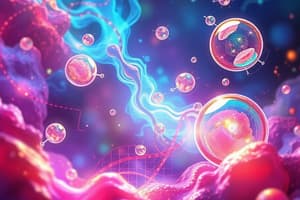Podcast
Questions and Answers
Why can ionic compounds conduct electricity when molten or in solution, but not in the solid state?
Why can ionic compounds conduct electricity when molten or in solution, but not in the solid state?
- In the solid state, the ions are fixed in a lattice and cannot move to carry charge. (correct)
- In the solid state, ionic bonds are too strong to allow electron flow.
- The presence of water molecules in solution facilitates electron transfer.
- Melting or dissolving the compound introduces free electrons.
Which statement accurately describes the movement of ions during electrolysis?
Which statement accurately describes the movement of ions during electrolysis?
- Cations move towards the anode, while anions move towards the cathode.
- Cations move towards the cathode, while anions move towards the anode. (correct)
- Anions move towards the cathode, completing the circuit.
- Both cations and anions move towards the anode.
Sulfur hexafluoride is used as an electrical insulator in transformers because:
Sulfur hexafluoride is used as an electrical insulator in transformers because:
- it is a covalent compound with free moving ions.
- it is a dense gas that prevents the flow of charged particles. (correct)
- it promotes electron flow at high voltages.
- it is an ionic compound with a high melting point.
Why do most covalent compounds not conduct electricity?
Why do most covalent compounds not conduct electricity?
Considering the properties of ionic and covalent compounds, which of the following applications relies on the conductive property of one and the insulating property of the other?
Considering the properties of ionic and covalent compounds, which of the following applications relies on the conductive property of one and the insulating property of the other?
Flashcards
Conductivity of covalent compounds
Conductivity of covalent compounds
Most covalent compounds do not conduct electricity due to lack of freely moving charged particles.
Insulators
Insulators
Covalent compounds act as insulators in solid, liquid, and gaseous forms.
Ionic compounds conductivity
Ionic compounds conductivity
Ionic compounds conduct electricity in molten state or in solution due to mobile ions.
Cations and anions
Cations and anions
Signup and view all the flashcards
Electrolysis
Electrolysis
Signup and view all the flashcards
Study Notes
Conductivity of Covalent Compounds
- Covalent compounds generally do not conduct electricity.
- This is because they lack freely moving charged particles (electrons or ions).
- They act as insulators in solid, liquid, and gaseous states.
- Examples include sulfur hexafluoride (used in electrical transformers), silicone oils, and liquid hydrocarbons (used in electrical equipment), and plastic coatings on electrical wiring.
Conductivity of Ionic Compounds
- Ionic compounds can conduct electricity in the molten state or in solution.
- This is due to the presence of mobile ions that can carry charge.
- In their solid state, ions are fixed in a crystal lattice and cannot move, preventing conductivity.
- Molten or aqueous ionic compounds conduct electricity.
Ions
- Anions: Negatively charged ions (Cl⁻, O²⁻, SO₄²⁻).
- Cations: Positively charged ions (K⁺, Mg²⁺, H⁺).
- During electrolysis, electrons move from the anode to the cathode.
- Cations in an electrolyte move towards the negatively charged cathode.
- Anions in an electrolyte move towards the positively charged anode.
- The attraction between oppositely charged ions (cations to cathode, anions to anode) drives their movement.
Studying That Suits You
Use AI to generate personalized quizzes and flashcards to suit your learning preferences.




